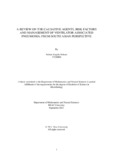A review on the causative agents, risk factors and management of ventilator associated Pneumonia: from South Asian perspective

View/Open
Date
2021-09Publisher
Brac UniversityAuthor
Naboni, Nahian SanjidaMetadata
Show full item recordAbstract
Ventilator Associated Pneumoniae (VAP) is a common hospital acquired pneumoniae in ICU patients. Patients with pneumoniae after 48 hours of mechanical ventilation is considered VAP. INICC found that VAP rates between 2003 to 2008, 2004 to 2009 and 2012 to 2017 as 13.6, 15.8 and 14.1 per 1000 episodes. VAP can be two types, early onset VAP and late onset VAP. The most common pathogens include Acinetobacter baumannii, Pseudomonas Aeruginosa and Klebsiella pneumoniae. Risk factors that increase the mortality of VAP are age, gender, increased in mechanical ventilation, disorder of consciousness, burns, comorbidities, prior antibiotic therapy, invasive operation, gene polymorphism and others. Blind bronchial sampling is used to collect endotracheal aspirates for identification and antibiotic susceptibility. Treatment protocol uses antibiotic therapy depend on the pathogens and their AST. For early onset VAP, cephalosporin (cefotaxime or ceftriaxone), a fluoroquinolone, or piperacillin-tazobactam and for late onset VAP, ceftazidime, ciprofloxacin, meropenem, and piperacillin-tazobactam.
